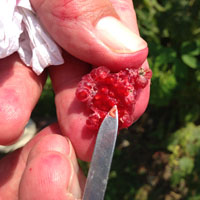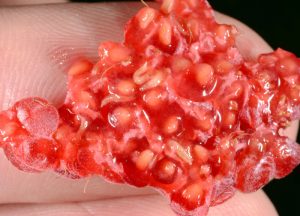Correction to September 5 In The Grow
New Pest Identified in Raspberries
I just learned from a couple of observant colleagues that the insect pest described in raspberry fruits in last week’s “In The Grow” column is most likely a new pest, the Spotted Wing Drosophila, that has recently appeared in Indiana. Here is the question and the amended response. Thanks to my colleagues for catching this! – Rosie Lerner
Q. I am just sick about my red raspberries. They’re just beautiful and full of large berries. But they are infested with tiny, tiny white worms. I noticed a little wet spot in the bottom of almost every berry, so upon closer investigation, I spotted the problem. What are they, and what should I do? I just watch the raspberries go to waste. I’ve had red raspberries for several years and never had such a problem. Will I have the same problem in the spring?
A. The tiny, white worms are most likely the Spotted Wing Drosophila (fruit fly), a new pest that has recently appeared in Indiana. This insect is a serious pest of soft fruits such as blackberries, raspberries, blueberries, grapes, strawberries, cherries and peaches. It can also infest apples, apricots and tomatoes, as well as weeds such as pokeweed, autumn olive, crabapple, nightshade, honeysuckle and wild grape. This aggressive, invasive pest is new to Indiana and is likely to be with us for the foreseeable future.
To determine if this is the culprit, tease open or crush the raspberry fruit carefully and look for larvae. They can initially be difficult to discern from the seeds in the pulp, but the larvae will be showing some motion while the numerous seeds will immobile. There can be several larvae in each berry. Any overripe or soft fruit is likely to be infested. If you find any evidence of infestation, Purdue entomologists suggest you spray immediately to try to knock down the population. You will probably need to make a second application a few days later to kill new adults that emerge after the initial application. Depending on how long your fruit harvest continues, you may need to reapply weekly. There are a number of insecticide products labeled for use on raspberries, including spinosad, pyrethroids and malathion, to combat this pest. Only use products that are labeled for use on raspberries, and be sure to follow the days-to-harvest limits listed on the label (likely 1-3 days). Do NOT apply any insecticides while the plants are in bloom. Controlling weeds around the raspberry planting can also help. For more information on the Spotted Wing Drosophila, see”Spotted Wing Drosophila Detected in Grapes and Berry Crops in Indiana.”

